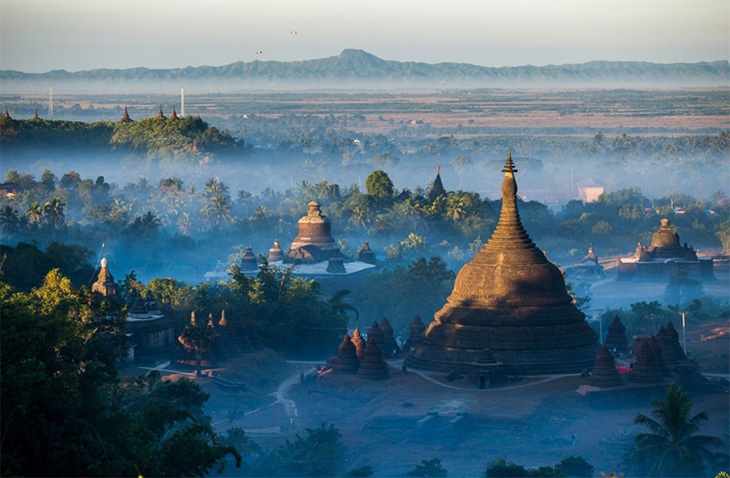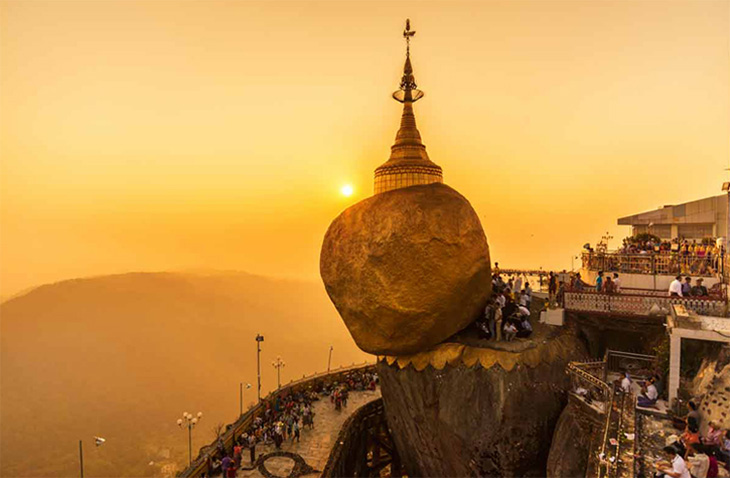
It's a nation on the cusp of great change, and there's never been a better time to go than right now. Find out why T+L has annointed it "Destination of the Year." You might want to wait until the country, formerly Burma, becomes a full-fledged democracy, possibly led by Daw Aung San Suu Kyi, winner of the Nobel Peace Prize and icon of righteous courage. You might want to wait until the Muslim problem settles down, and until the armed conflict with minority ethnic groups is resolved. You might hold out for utopia, as lots of Myanmar’s citizens appear to be doing. You might want to wait until it becomes what it is now becoming.
Golden stupas (or pagodas: the terms are interchangeable here) glitter in the sun wherever you go in Myanmar. In the shadow of these towers, peasants labor in rough conditions. One local drily remarked to me that the country is rich, but the people are poor. For many, life seems to have gone on largely unchanged for the past 2,500 years: peasants, oxcarts, the same kinds of food and clothes. The same glittering pagodas, covered in gold in the richer towns, and merely painted in the poor ones. Nothing ever happens when it should; it’s amazing that the sun sets on schedule. My voyage among these contradictions and inefficiencies was impeccably curated by GeoEx and went startlingly smoothly. They had designated as my guide the charming Aung Kyaw Myint, with whom my friends and I spent our time learning history, geography, culinary arts, and cultural fluency.

Shwedagon Pagoda
We began our trip in Yangon (formerly Rangoon), the heart of the country. Its Shwedagon Pagoda is among the holiest sites in the land, and people come from near and far to worship at it. The central stupa is covered in gold—not gold leaf, but thick plates of solid gold—and there are receptacles full of jewels near its apex. The Burmese maintain that the pagoda is worth more than the Bank of England. Incongruous amid the modernizing city, it feels momentous and transcendent, a sort of St. Peter’s Basilica of Theravada Buddhism. At Burmese pagodas, you are required to take off your shoes as a mark of respect. When President Obama visited in 2012, the secret service protested that its agents couldn’t be barefoot, but at his insistence, they broke a previously unequivocal rule and removed their footwear, and the President paid his respects.
Early the next morning, we boarded a boat for the five-hour ride to Mrauk-U, an imperial capital from the 15th to the 18th century. If you make it to Myanmar, take as many boats as you can. The life of the country unfolds on the rivers, and they make for smoother journeys than the badly paved roads. Everyday scenes appear as picturesquely as in genre paintings, the breeze is delightful, and there is always another pagoda ahead. If you are staying at the Princess Resort in Mrauk-U, you will get to embark in one of its old wooden barges—and the food on board is delicious.

Ratanabon Paya Mrauk U
The Golden Rock itself is an extraordinary sight: a boulder, nearly round, 20 feet in diameter, balanced on the edge of the mountain as if on the verge of plummeting. Legend holds that three hairs of the Buddha keep it on its precarious perch. The entire rock is covered in gold leaf, which devoted pilgrims keep adding, so that in some places, the gold is an inch thick and stands out in lumps. Atop the rock, far out of reach, is the Kyaiktiyo Pagoda. The gold orb glows at sunrise, in afternoon light, at sunset, in the floodlit nighttime. When the light changes, the effect shifts subtly, but it is never less than awe-inspiring. We climbed under it, stood beside it; from every vantage, one feels the fragility of its odd balance, the drama of its massive heft, and the tranquillity that holy places can have. It has the grandeur of a fire, or a rushing river, or a mountaintop panorama. We descended the mountain by pasha-worthy sedan chairs, surveying the surrounding jungle in a semi-recumbent posture.

The Golden Rock (Kyaik Hti Yoe Pagoda)
People I met shook their heads over such development, but they had made their peace with tougher things. I was surprised at first by the fact that the country is not in a time of tremendous optimism—but I was astonished in the end by the pervasive equanimity that seemed to exist among even those with little hope of personal betterment. There was not so much optimism in Myanmar, but there was also very little pessimism, which is perhaps a high expression of the country’s Theravadan ideals.

 (+95-9) 7757 30372
(+95-9) 7757 30372


